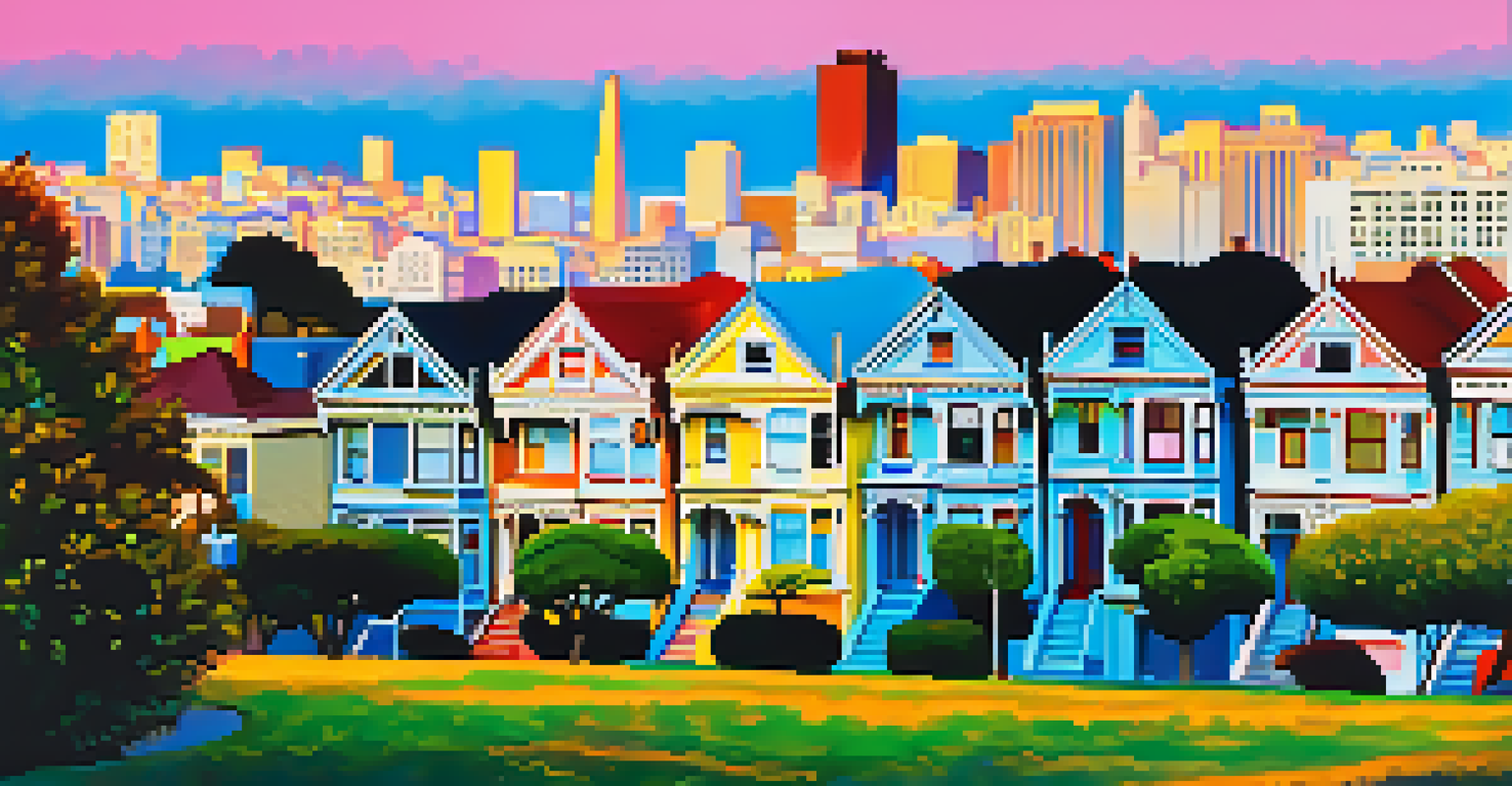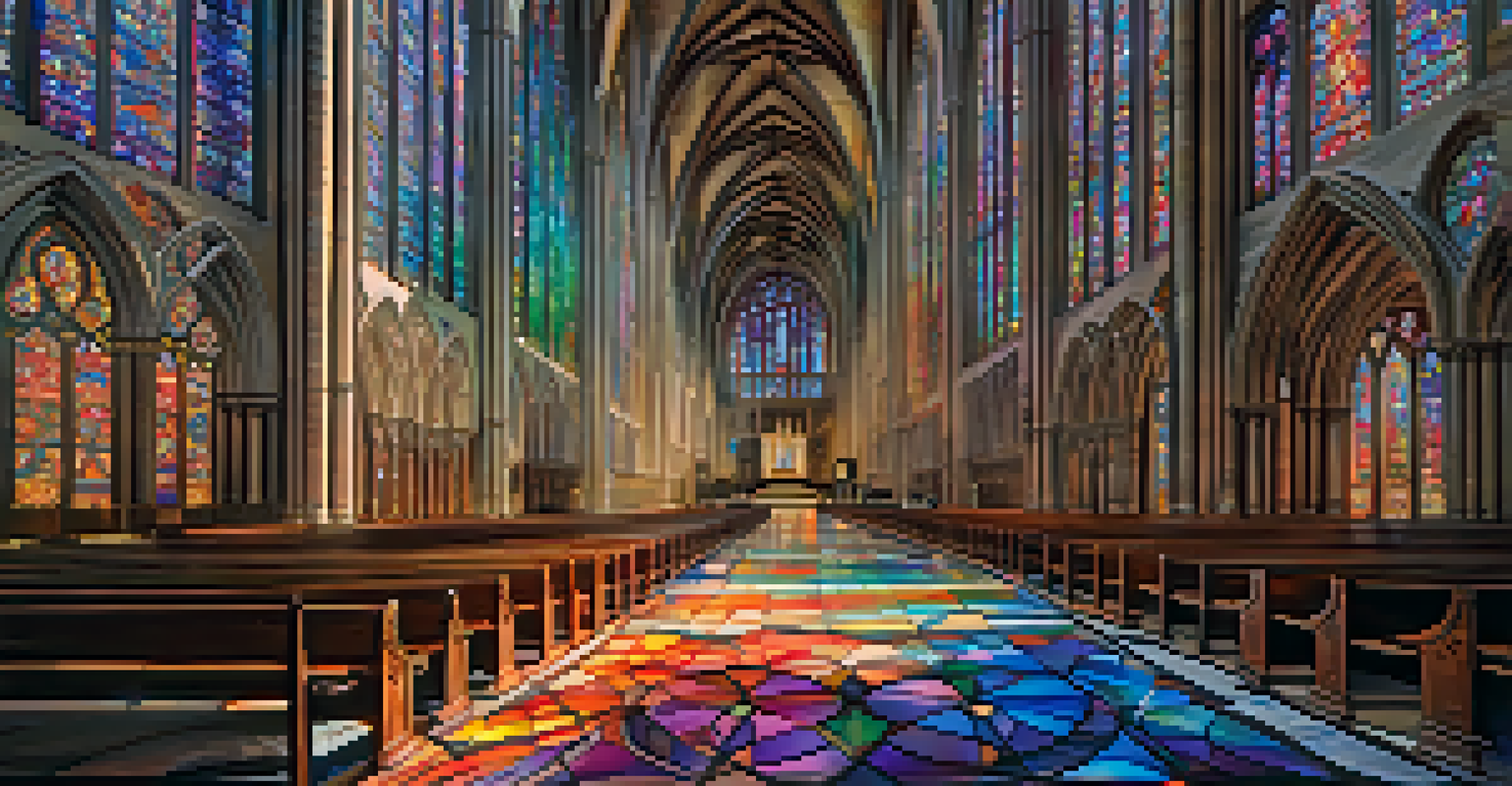Exploring the Architectural Wonders of San Francisco's Landmarks

The Golden Gate Bridge: A Marvel of Engineering and Design
The Golden Gate Bridge stands as an iconic symbol of San Francisco and an engineering marvel. Completed in 1937, it spans approximately 1.7 miles and was once the longest suspension bridge in the world. Its Art Deco design, combined with its striking International Orange color, makes it a favorite subject for photographers and tourists alike.
Architecture is the art of how to waste space.
Walking across the bridge offers breathtaking views of the city skyline and the Pacific Ocean, making it an unforgettable experience. The bridge's towers reach 746 feet into the sky, and standing beneath them can make you feel quite small in the best way possible. The careful balance of aesthetics and functionality in its design has ensured that it remains a vital transportation link today.
Interestingly, the bridge's color was chosen not just for its beauty but for visibility in San Francisco's frequent fog. This thoughtful design choice highlights how aesthetics and practicality can go hand in hand, and it's a testament to the innovative spirit of the early 20th century.
Alcatraz Island: A Historical Fortress with Unique Architecture
Alcatraz Island, famously home to the now-closed federal prison, offers a unique glimpse into history and architecture. The main prison building, known as the Cellhouse, features a stark, utilitarian design that stands in contrast to the island's natural beauty. Built in the 1930s, its imposing structure tells stories of infamous criminals and daring escapes.

Beyond the prison, the island itself is dotted with historic structures, including the lighthouse built in 1854, one of the oldest on the West Coast. The juxtaposition of the rugged natural landscape and the man-made structures creates a hauntingly beautiful atmosphere that draws visitors from around the globe. Walking through the Cellhouse, you can almost hear the echoes of the past.
San Francisco's Architectural Diversity
The city showcases a rich tapestry of architectural styles, from Victorian homes to modern skyscrapers, reflecting its historical evolution and cultural vibrancy.
Alcatraz serves not only as a reminder of America's penal history but also as a canvas for the evolution of architectural styles in response to function and environment. The island's preservation efforts ensure that its stories and structures can be appreciated by future generations.
The Painted Ladies: A Colorful Display of Victorian Architecture
The Painted Ladies are a row of Victorian houses that showcase the charm and character of San Francisco's architectural heritage. These colorful homes, often featured in movies and postcards, are located across from Alamo Square Park, offering a stunning backdrop of the city skyline. Their intricate designs and vibrant hues make them a beloved icon of the city.
The details are not the details. They make the design.
Constructed in the late 1800s, these homes represent a specific style known as 'Victorian,' characterized by ornate details and bold colors. Each house has its unique flair, yet they collectively create a picturesque scene that captures the essence of San Francisco's history. The term 'Painted Ladies' refers to this distinctive style, which has become synonymous with the city.
Visiting the Painted Ladies is like stepping back in time, allowing you to appreciate the craftsmanship and artistry of the era. It's no wonder this site has become a must-see for anyone exploring the city's architectural gems.
The Ferry Building: A Culinary and Architectural Hub
The Ferry Building, a stunning example of Beaux-Arts architecture, is more than just a transportation hub; it's a vibrant marketplace. Completed in 1898, its clock tower is a prominent feature of the San Francisco waterfront, welcoming visitors with its historic charm. The building's design combines functionality with elegance, making it a beloved landmark.
Inside, the Ferry Building Marketplace offers a feast for the senses, showcasing local artisans, gourmet food vendors, and restaurants. This blend of architecture and culinary delights creates an inviting atmosphere where locals and tourists alike gather. The building not only serves as a transit point but also as a community center that celebrates the city’s rich food culture.
Iconic Landmarks and Their Stories
Structures like the Golden Gate Bridge, Alcatraz Island, and the Ferry Building not only serve as landmarks but also tell compelling stories of engineering, history, and community.
The Ferry Building is a perfect example of how architecture can foster community interaction and cultural appreciation. Its restoration and revitalization highlight the importance of preserving history while adapting to modern needs, creating a space where the past and present coexist beautifully.
The Transamerica Pyramid: A Modern Icon of the Skyline
The Transamerica Pyramid is one of San Francisco's most recognizable modern landmarks, soaring 853 feet into the sky. Completed in 1972, its unique shape and sleek design set it apart from the city's traditional architectural styles. The pyramid's sharp angles and glass facade reflect the innovation of the era, making it a symbol of the city's growth and evolution.
While some may see it as a controversial addition to the skyline, the pyramid has become an integral part of San Francisco’s identity. Its design not only maximizes office space but also minimizes wind resistance, showcasing thoughtful engineering. The observation deck offers stunning views of the Bay Area, allowing visitors to appreciate the city from a new perspective.
The Transamerica Pyramid represents a shift towards modernism in architecture, blending functionality with a distinctive aesthetic. Its presence reminds us of how cities evolve, and how new structures can coexist with historic landmarks, creating a dynamic urban landscape.
Grace Cathedral: A Majestic Reflection of Gothic Revival Style
Grace Cathedral is a stunning example of Gothic Revival architecture, nestled in the heart of San Francisco. Completed in 1964, it was inspired by the famous Notre-Dame Cathedral in Paris and features intricate stained glass windows and beautiful stonework. This majestic structure not only serves as a place of worship but also as an artistic and cultural hub.
The cathedral's 44-foot high nave and soaring ceilings create an awe-inspiring atmosphere that invites contemplation and reflection. Visitors can explore its labyrinth, a meditative pathway that connects one to the spiritual essence of the space. The design elements reflect a reverence for tradition while embracing contemporary artistic expressions.
Preservation of Cultural Heritage
Efforts to restore and maintain historic sites like the Palace of Fine Arts and Grace Cathedral ensure that San Francisco's artistic and cultural legacy continues to inspire future generations.
Grace Cathedral stands as a testament to the power of architecture in creating sacred spaces. Its beauty and serenity provide a welcome respite from the bustling city, making it a must-visit for anyone seeking inspiration and tranquility.
The Palace of Fine Arts: A Timeless Architectural Treasure
The Palace of Fine Arts is a stunning architectural landmark that transports visitors to a world of classical beauty. Originally constructed for the 1915 Panama-Pacific Exposition, it features a grand rotunda and a serene lagoon. Its neoclassical design, complete with Corinthian columns and a stunning dome, captures the imagination and serves as a popular spot for photography.
The Palace has undergone several restorations to preserve its elegance and charm over the years. Strolling around the lagoon, visitors can enjoy the picturesque scenery, often accompanied by the sounds of nature and laughter from families enjoying the space. The blend of architecture with the natural landscape creates a peaceful retreat in the heart of the city.

Today, the Palace of Fine Arts stands as a reminder of San Francisco's rich cultural history and artistic aspirations. It serves as a venue for various events, performances, and exhibitions, ensuring that its legacy continues to thrive in the modern era.
Exploring the Diversity of San Francisco's Architectural Styles
San Francisco's architectural landscape is a tapestry woven from various styles and historical influences. From Victorian and Edwardian homes to modern skyscrapers, each building tells a story of the city's evolution. This diversity reflects not only the city’s rich history but also its embrace of innovation and change.
Walking through neighborhoods like the Mission District or Nob Hill, you can see how different architectural styles coexist, creating a unique urban character. The blend of old and new, traditional and contemporary, offers insights into the cultural fabric of the city. Each structure contributes to the overall narrative of San Francisco, making it a living museum of architectural history.
Exploring these diverse styles invites appreciation for the artistry and craftsmanship involved in creating these landmarks. Whether you're a history buff, an architecture enthusiast, or simply a curious traveler, discovering San Francisco's architectural wonders is an enriching experience that highlights the city’s vibrant identity.